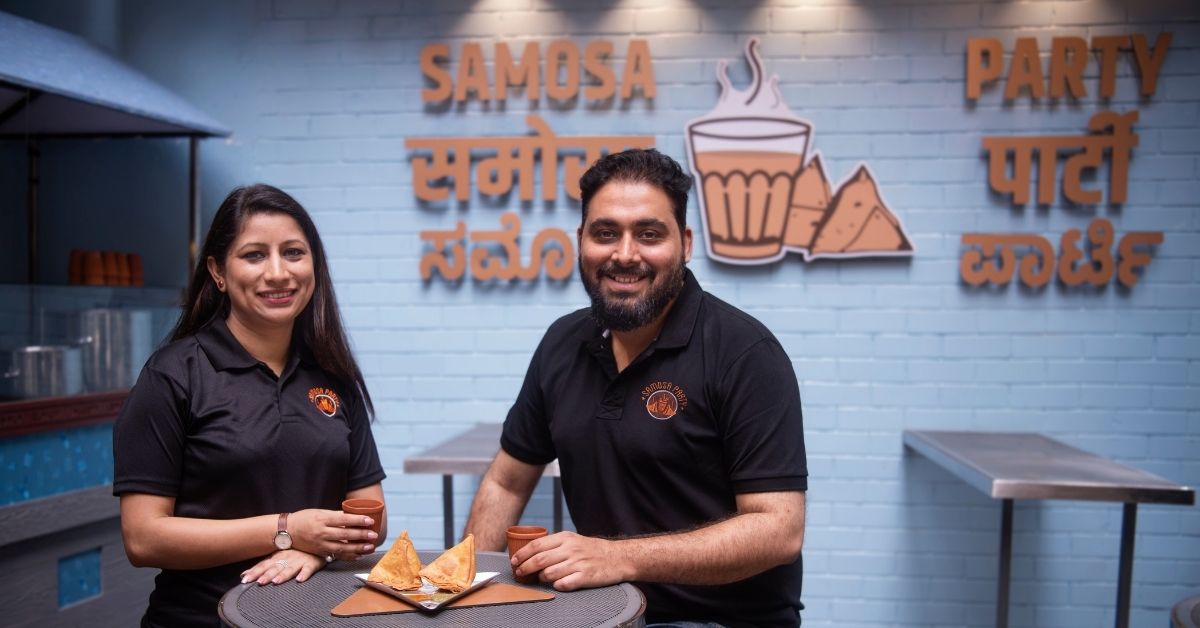How We Made And Sold Over 25 Lakh Samosas To Build Our Dream Startup
Amit Nanwani and Diksha Pande started Bengaluru-based Samosa Party in 2017, with an aim to provide a hygienic yet authentic alternative to India’s favourite snack.

To say that the samosa is India’s staple snack would not be much of a reach. The deep-fried triangular pastry, usually stuffed with spicy potatoes and peas, or meat, transcends regional and class boundaries to offer the country something we all can agree to love.
Amit Nanwani and Diksha Pande, who started Samosa Party in 2017, have always been well aware of this fact. The former, who hails from Indore, says street food has always been an integral part of who he is. Having worked in the corporate world for six years, he ended up relocating to many other cities.
“When I moved to cities like Bengaluru, Mumbai and Gurgaon, I found their street food to be not at par, in terms of taste and authenticity. This held especially true for samosas, which are one of the most consumed snacks in India. In fact, our research found that around six crore samosas are consumed in India every day. Yet, no one was doing justice to the product,” he tells The Better India.
Amit says he found two extremes when it came to the availability of samosas. “They were either being made under extremely unhygienic conditions, or being sold by really high-end and fancy restaurants. But in the case of the latter, these were often samosas that were already made and frozen, and would be reheated as per requirement. So they weren’t exactly fresh, and were often soggy,” he adds.
Amit met Diksha, who hails from Nainital, when the latter was working with Pizza Hut’s innovation section. “We discussed how there was no global brand recall for Indian street food. We knew that the only food item from the country that was globally and democratically scalable was street food, especially in the QSR (quick service restaurant) field. Whenever someone from outside India comes to visit, they often get to hear a lot about street food, but how often do they get to actually consume it? Due to concerns regarding an unhygienic environment, they often don’t get to actually experience the wonders of Indian street food,” she tells The Better India.
Diksha has always worked in the Food and Beverage sector. Before she began her venture, she was working with a popular Indian tea company and cafe chain. “I saw that whenever people would order tea, they would also often order samosas, but customer satisfaction always scored low. The snack is a natural fit with chai, but the experience is very compromised,” she notes, and adds, “There is a dearth of ventures that produce samosas on a large scale while maintaining hygiene and retaining authenticity.”
The automated samosa experience

This gap is what eventually led to the formation of Samosa Party, which is based in Bengaluru. Samosas, Diksha says, are very delivery-friendly products, and the idea was to build something along the lines of — “when people think of samosas, they should think of Samosa Party”.
“Our idea wasn’t to change the customer’s experience when it comes to the consumption of samosas,” Amit tells The Better India, and adds, “It was to elevate it. Our aim is to stay authentic. We have just taken a contemporary approach to selling it.”
This contemporary approach was a challenge, he says. “In India, food technology hasn’t scaled as well, when you compare it with other technologies across the world. Take China, for example. The process of making noodles is automated in the area. In European countries, the process of making bread is also automated. In our country, whether it’s samosa or biryani, the dishes are mostly hand-made, right from scratch,” he adds.
Making samosas looks easy, he says, but the process is extremely skill-based and time-consuming. “Not everyone can make them the way halwais do. When you’re making a dish by hand, it becomes difficult to standardise it across outlets.”
Amit and Diksha started by breaking down the entire process in which samosas are made. “From the doughing to the kneading, sheeting, cutting, filling, and closing, we broke all of it down and started automating the process bit by bit. Today, 75% of our entire samosa-making process is automated,” he says.
Samosa Party currently has 10 outlets across Bengaluru, and they receive up to 1,000 orders a day (about 30,000 orders a month), and have sold over 25 lakh samosas so far. At any given time, around 12 varieties of samosas are sold, but the menu is ever-changing. Around the time of festivities or any such celebrations, Diksha and Amit modify their menu. For now, they’re gearing up to make recipes specific to Holi, like gujiya samosas served with thandai. During the COVID-19 lockdown, they sold around 8 lakh samosas.
Samosa: The homely, comforting snack

“What’s wonderful about this venture is that while selling samosas, we ended up discovering so many new things about how this snack is eaten. Especially in the time of the pandemic, people looked to it for comfort and familiarity. We receive a lot of orders from people who miss home. But even otherwise, before coronavirus, people who would come into our walk-in stores would often say, ‘Isko khaake ghar ki yaad aa gayi (Eating this reminded me of home)’. Samosas are so homely and deeply connected to our roots, and it gives us so much satisfaction that we can bring this slice of joy for our customers,” Diksha says.
Today, Samosa Party receives numerous orders for corporate events and large gatherings. “We scaled our business when we received an order for 4,000 samosas for a college festival,” Diksha says, and adds, “Besides Samosa Party, no one else could fulfill this requirement, on demand, in Bengaluru. From here, we began working on bulk orders. We sell a box of 50 samosas, which are all fried immediately before being sold, as opposed to being stored and kept for frying later. This way, we’re ensuring our consumers get fresh products every time they order. They will be available in 30 minutes. We receive a lot of orders for these boxes from schools, colleges, and offices.”
Speaking about the shifts that COVID-19 brought to the business, Amit says, “Our USP is that we always emphasised on hygiene. People looked at us when they thought of sanitary street food. COVID-19 only led to the enhancement of that since our samosas are always freshly fried, at a temperature of 130 degree Celsius.”
Regardless, keeping up the operations of existing facilities was challenging. “We had to ensure our team’s safety. We made sure they had accommodation and food was provided to them, because they couldn’t step out,” he adds.
Samosa Party has around 80 people on their team who, Diksha says, come from various backgrounds. Some come with prior experience in the process of making samosas, which has been a big help to the venture.
The bootstrapped startup raised Series A Funding from investors at IPV (Inflection Point Ventures) in August 2020.
In terms of plans for the future, Samosa Party plans to expand to NCR, and has an outlet in Gurgaon coming up by the end of January. “We will simultaneously continue expanding in Bengaluru. We got a lot of requests from customers who wanted ready-to-eat or ready-to-fry products, so we’re also looking into that right now. These will be available across India. After we cover NCR, we will move to Hyderabad and Chennai,” Amit says.
For orders, or more information, you can visit Samosa Party’s website.
(Edited by Yoshita Rao)
This story made me
- 97
- 121
- 89
- 167
Tell Us More
We bring stories straight from the heart of India, to inspire millions and create a wave of impact. Our positive movement is growing bigger everyday, and we would love for you to join it.
Please contribute whatever you can, every little penny helps our team in bringing you more stories that support dreams and spread hope.



















